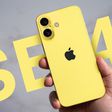68% of Americans are expected to own an iPhone when the smartphone market reaches its saturation point in 2017, according to new research done by Asymco analyst Horace Dediu. Citing a parallel between the growth of the smartphone market and the growth of the iPhone over the years, Dediu predicts that both will continue to grow alongside each other as the smartphone market hits a saturation point at 90% in February 2017 with a predicted 180 million U.S. iPhone owners by that time, giving Apple a 68% market share.

If we believe that the iPhone can be modeled behaviorally then it may be possible to forecast its growth. One can simply draw a line extending the existing red segment above and read the F/(1-F) figure at any point in time. Solving for F results in a measure of penetration and hence number of users (if population is known.)
An alternative is to use the following formula derived from the linear interpolation of the two measured market shares. iPhone market share is y/(1+y) where y=0.21x and x = F/(1-F) and F is the expected market penetration of smartphones.
So if F = 91%, x = 10, y = 2.11 and therefore the iPhone market share = 68%.
We also know from the plot of the market that F = .91 is reached around February 2017. So we can suggest that at 90% penetration (approximately saturation) the iPhone will have 68% market share of users in the US. Forecasting the addressable market (US population aged older than 13) at about 266 million that implies 180 million US users of the iPhone by early 2017.
As Forbes points out, the idea of smartphones being used by 90% of the population by Dediu's projected date would mean that the market would hit full saturation less than 10 years since the introduction of the original iPhone, making smartphones the fastest adopted technology in history:
And the remarkable thing about this is that the smartphone won’t even be ten years old by that point. Yes, the first real smartphone (there were attempts before this but nothing that really grasped peoples’ attention) was indeed the iPhone and it was released in 2007. But not until June: so if market saturation comes in Feb 2017 then market saturation will come in just under a decade.
And that is just amazing, stupendous in fact. It makes the smartphone by far the fastest adopted technology ever.
According to data from research firm Kantar Worldpanel posted earlier this month, the iPhone's market share in the U.S. hit 52.8% in October following the launch of the iPhone 5s and the iPhone 5c. In the previous year, Apple's market share was at 53.3% following the launch of the iPhone 5, and was at 36% and 25% in the two years prior with the launch of the iPhone 4S and iPhone 4, respectively.




















